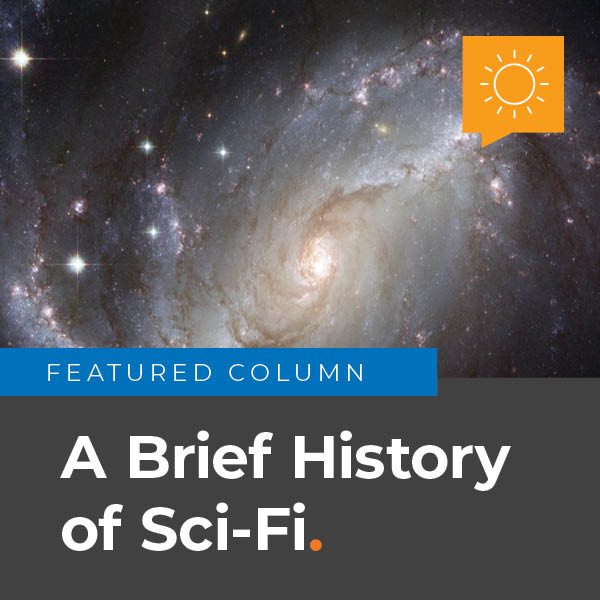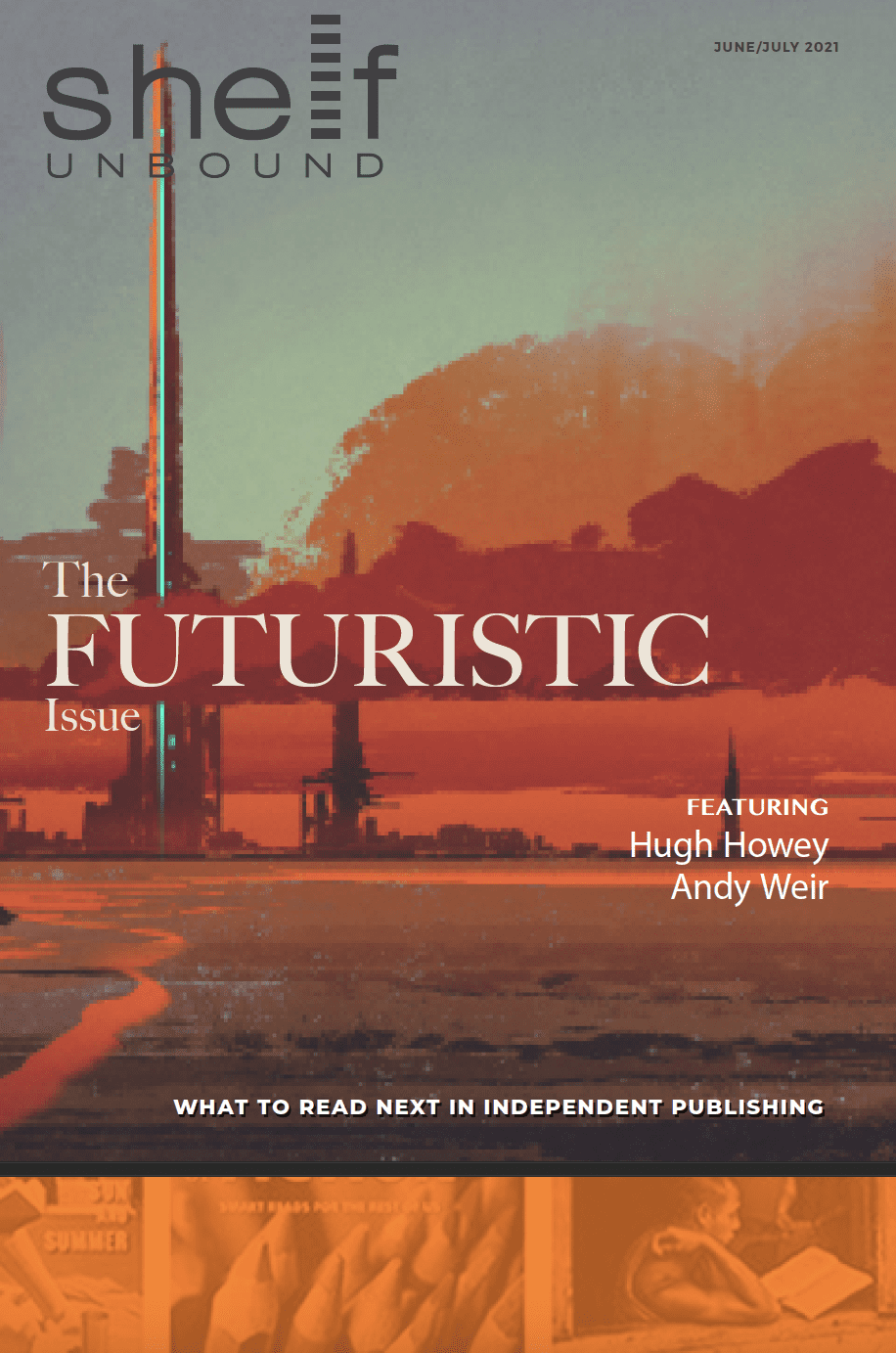By ALYSE MGRDICHIAN

Sci-fi is a genre that has been evolving for the past 100+ years, since our collective imagination shifts and progresses alongside our understanding of the scientific world. This means that sci-fi has changed over time, with each book being influenced by the one before it. With that in mind, below is a list of 15 literary contributions to the sci-fi genre, paired with descriptions of what each book/series has added to the realm of speculative fiction.
Keep in mind that the ordering of this list is in no way indicative of quality, but is instead chronological (spanning from the 1800s to present day). Additionally, there are countless sci-fi books in the canon of the genre, so please keep in mind that your personal favorites may not be present—if I were to recount the full list I’d originally had in mind, it would take up most (if not all) of this magazine, so the list has been shortened for the sake of my own sanity (and the sanity of our lovely editor, bless her).
Finally, the books in this article are listed on their own merit, separate from the beliefs and practices of their authors—however, I feel the need to note that stories should not be read in a vacuum, and the problematic views of an author should be acknowledged and addressed when approaching their work in any way. In other words, an author can contribute immensely to the growth of a genre, but those contributions in no way excuse their hateful and/or prejudiced beliefs. So, use your own discretion when choosing to read books by certain authors on this list.
With these brief disclaimers in mind, let’s take a look at some of the books that have contributed to the past, present, and future of what sci-fi looks like as a genre.

1. Frankenstein by Mary Shelley (1818)
Considered by many to be one of the very first sci-fi books ever written. Although sci-fi short stories existed at this point in time, Mary Shelley is credited for introducing the novelized format of the genre that we know today. The book itself is a classic gothic tale about existential dread, the effects of isolation, and the ethical responsibilities of creator vs. creation, taking a very philosophical tone. Shelley also introduced the now-famous “mad scientist” archetype via Dr. Victor Frankenstein, who is now considered the prototype for other such characters.

2. 20,000 Leagues Under the Sea by Jules Verne (1870)
Another foundational sci-fi book, not just because of the underwater adventures, but because of Jules Verne’s ability to use a combination of imagination and hard science to predict future technology. The most famous of the book’s predictions is that of the electric submarine, written when submarines had already been invented but when electricity and its potential were still quite mysterious. By the late 1880s, though, and throughout the 20th century, attempts were being made to develop fully safe/operational electric submarines (which are now the norm for us).

3. We by Yevgeny Zamyatin (1924)
Known today as the first dystopian novel. Written by Yevgeny Zamyatin, the story delves into the themes of order and chaos, portraying what happens when government regimentation is taken to extremes. A unique aspect of the story is how the futuristic collectivist state (written as a satire) asserts its control over its people, namely by subjecting its citizens to a surgery that destroys the area of the brain responsible for imagination and passion—in this dystopia, the soul is chaos, and so order is brought by destroying it.

4. The Call of Cthulhu by H.P. Lovecraft (1928)
Although a short story, is on this list because it is one of the many tales of H.P. Lovecraft credited for introducing the cosmic horror sub-genre. In particular, up until this point in time, antagonistic threats of sci-fi books were usually aliens, AI, or humanity itself, but Lovecraft’s stories introduced the idea of hostile eldritch beings—in this case, “The Old Ones,” a group of malevolent and grotesque former gods whose visage and power alike are incomprehensible, resulting in the complete and utter helplessness of the stories’ human protagonists.

5. 1984 by George Orwell (1949)
Remains one of the most famous dystopias ever written. Although George Orwell took inspiration from We (Zamyatin), 1984 has become synonymous with the dystopian sub-genre. Additionally, even though the world that Orwell presents is fabricated, it remains ever-applicable, since the book focuses largely on the role (and manipulation) of truth in politics. With other elements such as an omnipresent government, suppression of information, and perpetual war, 1984’s totalitarian setting is one that feels eerily possible.

6. I, Robot by Isaac Asimov (1950)
A collection of short stories about robots coexisting with humans. Isaac Asimov predominantly explores the moral implications of AI, also introducing the Three Laws of Robotics, which have influenced the future of AI-based stories. To paraphrase, a robot must 1) not allow a human to be harmed, whether through action or inaction; 2) obey orders given by humans [unless doing so conflicts with #1]; 3) protect its own existence [unless doing so conflicts with #1 or #2]. Asimov’s stories reveal the unintended consequences and loopholes of this programming, following how robots interact with organic and inorganic life-forms in light of it.

7. Dune by Frank Herbert (1965-1985)
A series by Frank Herbert, is widely credited for popularizing the space opera sub-genre. Although it was not the first of its kind, it is certainly the best known, influencing the galactic adventure stories that have followed (e.g., Star Wars). Herbert does not delve deeply into technology here, contrary to the focus of most futuristic space-based stories, instead opting to focus on politics, environmentalism, mysticism, and human relationships. With this in mind, the series has become a staple of soft science fiction.

8. Do Androids Dream of Electric Sheep? by Philip K. Dick (1968)
Takes place in a post-apocalyptic world after a nuclear war has endangered (if not completely wiped out) most of Earth’s animal species. Based in digital futurism, the story follows a bounty hunter who is tasked with destroying androids who, being nearly indistinguishable from humans, have escaped servitude and are trying to blend in with society. In this way, the story is one of humans vs. technology, empathy, environmental responsibility, and life/existentialism, with subsequent films taking inspiration from the book and its themes (e.g., Blade Runner).

9. The Hitchhiker’s Guide to The Galaxy by Douglas Adams (1979)
A classic, not because it is a profound dystopian or an epic space opera, but rather because it was one of the first books to demonstrate that sci-fi doesn’t always have to take itself seriously, and that it can, in fact, be incredibly funny. With a dry sense of humor, the story follows a human saved at the last minute from Earth’s destruction, now forced to wander the cosmos as a nomad. The blurb doesn’t do the weirdness and hilarity of the story justice, though—just trust me, it’s the only book that’s ever made me snort in public.

10. Neuromancer by William Gibson (1984)
An established landmark in the cyberpunk sub-genre, and is a particularly impressive debut novel. In this book, William Gibson takes a predictive (and often uncomfortable) look at what the direct integration of man and computer might look like, creating an interesting environment based in digital futurism. Acting as inspiration for subsequent futuristic stories (e.g., The Matrix), Neuromancer, although not the first book to tackle cyberpunk, is arguably the most influential.

11. The Handmaid’s Tale by Margaret Atwood (1985)
A classic, existing as one of the few recognized dystopian books of its time to have a woman-focused narrative and struggle. Based in the near future in what was once America, Margaret Atwood presents theocratic fundamentalism as the dystopian setting, which has been put into place in response to mass infertility. Potentially fertile women are forced to bear the children of upper class couples, and the narrative follows the perspective of one of these women.

12. The Three-Body Problem Series by Cixin Liu (2008-2010)
A more modern addition to this list, and is an impressive example of how high-concept sci-fi can delve into both hard and soft science. In this trilogy, Cixin Liu follows a broken and divided humanity after they learn that an alien civilization, out of necessity, plans to invade earth. Do they welcome the aliens, do they fight, or do they give up? Liu explores each, and isn’t afraid to unveil the ugly potential of what humans can (and will) do when desperate.

13. The Martian by Andy Weir (2011)
Recognized today as one of the best-known modern sci-fi books. Following an American astronaut who becomes stranded alone on Mars, the story is one of loneliness, dogged determination, and improvised survival. With a mix of wit and scientific knowledge, Andy Weir presents a protagonist who is not only easy to root for, but is also believably intelligent, letting hard science inform the character’s mission to make a habitable environment for himself on Mars.

14. The Southern Reach Trilogy by Jeff VanderMeer (2014)
A great modern example of well-executed cosmic horror, with Jeff VanderMeer dealing with themes like the loss of sanity, the insignificance of humanity, and one’s helplessness in the face of the incomprehensible. The series’ most tangible horror element stems from Area X, a marshy coastline that has been altered and warped by an unknown source—anything that crosses its borders cannot be recovered, and those who enter must face its physical and psychological horrors.

15. The Broken Earth Trilogy by N.K. Jemisin (2015-2017)
not only does a good job of straddling the line between creativity and convention, but also handles sensitive societal topics in ways that are groundbreaking for the genre. N.K. Jemisin’s macro and micro world-building are hugely impressive, as she manages to take a fictional landscape and use it to create real-world opportunities for conversation, specifically regarding who holds power, how the marginalized are treated, and how the powerful profit from marginalization.
Conclusion
Sci-fi has a long and varied history, but hasn’t been very diverse in its authorship (since certain demographics have, historically, been afforded more opportunities in publishing than others). However, as the genre continues to evolve and grow, the doors are opening wider for new perspectives, and the table is getting longer in order to accommodate more seats.
Humans are innately storytelling creatures, and the way we tell our stories will grow and change as we do—so, I’m excited to see where the dreamers of tomorrow will take sci-fi next!

